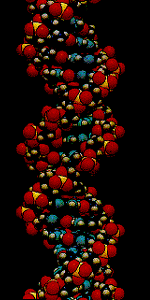
Genetic drift, which is chance fluctuation in the gene pool, can alter the frequencies of alleles. (The gene for a particular characteristic, such as flower colour (or eye colour, height, etc.) can be found at a specific location on a chromosome. When that gene has variants, they're called alleles. The extremely bad resolution diagram to the left shows that the gene for flower colour exists in two versions. (Campbell, 1994)
 A population must be sufficiently small for genetic drift to have an effect on evolution. Methods of genetic drift include mutation and recombination, which occurs during reproduction when chromosomes trade some of their genes by crossing over.
A population must be sufficiently small for genetic drift to have an effect on evolution. Methods of genetic drift include mutation and recombination, which occurs during reproduction when chromosomes trade some of their genes by crossing over.
The bottle effect and the founder effect;
The bottleneck effect occurs when the size of a population is reduced drastically, at random through a disaster such as floods, fires or earthquakes. The resulting small population's genes are unlikely to be representative of the original population makeup. By chance, certain alleles will be overrepresented, others under represented, and others completely eliminated. Genetic drift may affect the population for generations, until the population becomes large enough for sampling errors to become insignificant.
Genetic drift also has an effect whenever a few individuals colonize a small isolated island, lake, or some new habitat. (Campbell, 1994)
A classic example of the founder effect occurred on the Galapagos Islands.
